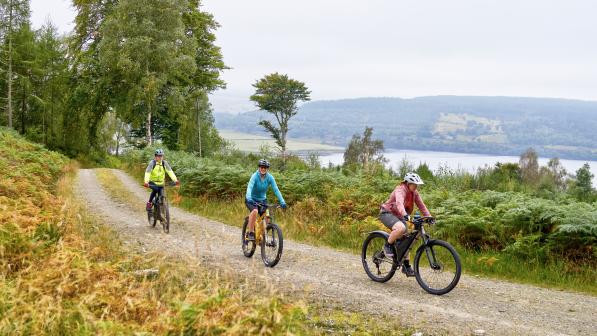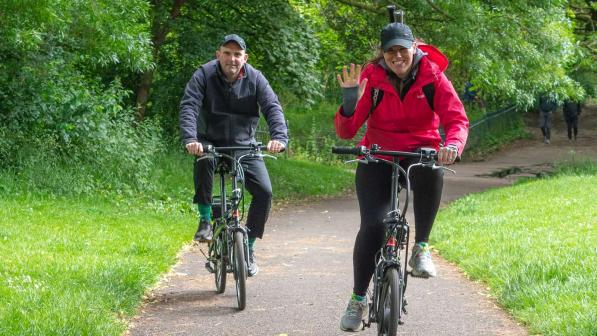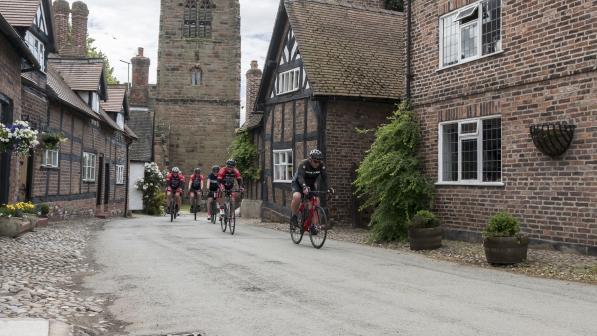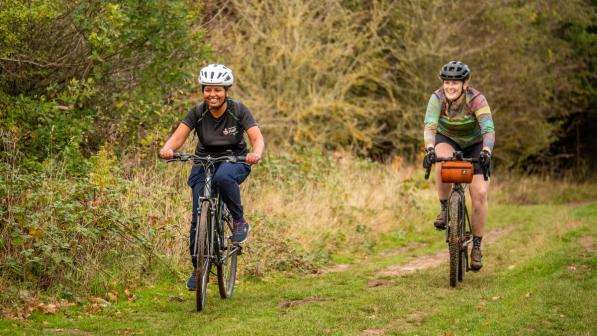10 ways to … take your cycling to the next level

You’ve been cycling a while now, you enjoy it and you want to do more – go further or faster, try something different. Maybe you took up cycling as a cheap, quick and environmentally friendly alternative to getting to work but you’ve been bitten by the cycling bug and you don’t know how to get to the next level.
That’s what happened to me. I moved so that I was no longer in walking distance of the office. Rather than use the expensive, crowded and sweaty Tube, I got a cheap hybrid for my birthday. Within a few months I’d upgraded to a road bike and signed up to the Wiggle Dragon Ride. WARNING: cycling can be habit forming.
If you’re looking for some ways take your cycling to the next level, here are our top 10 tips.
1. Identify what you want from your cycling
This is the first step. Not everyone wants to go from a five-mile ride to work to a 100-miler in Welsh mountains, so think about what it is you want to achieve. Do you want to get fitter and faster? Ride for longer? Try something new? Enter a long-distance charity ride? Maybe even take up racing?
Cycling is incredibly versatile and no matter how long you’ve been doing it for there’s almost certainly something more for you try. But it does mean you can get lost among all the options and try to do too much. Identifying exactly what you want to achieve gives you something to work towards and means you have a goal that everything else can be planned around.
2. Set yourself a challenge
So you’ve got a general idea of what you want to achieve, now it’s time to set some specific goals. Having a challenge to work towards will focus your mind and help keep you motivated.
The challenge can be as big or small as you like. The important things are to ensure it’s specific to what you want to achieve and attainable. If you want to spend more time in the saddle you could commit to riding every Sunday throughout the year, or you could go bigger and aim to ride 2,024km in 2024.
Perhaps you’ve done some off-road riding and now you’re intrigued by bikepacking. You could aim to spend one night under the stars this summer or plan a longer trip on one of Cycling UK’s long-distance routes. You don’t have to ride the whole thing – just plan for what you think you can achieve.
Be realistic. If you set yourself a challenge too far you’ll get disheartened and give up. But at the same time, don’t be afraid to push yourself. It is meant to be challenging after all!

3. Upgrade your gear
While you can start riding on almost any bike wearing comfortable clothes, if you want to improve your riding, it’s likely you’ll need to invest in your kit. If you want to take up racing, for example, you’ll need an appropriate bike and, yes, Lycra.
It doesn’t have to cost a fortune and exactly what you need will depend on your goals. If you fancy long-distance touring you’ll need a decent touring bike with mountings for sufficient bags. You’ll also need the bags. You’ll want clothing that’s fast drying and lightweight.
You don’t necessarily need a new bike. Upgrading certain components can make a huge difference to your ride. You might already have a good mountain bike that could double as a tourer, but upgrading the saddle could make all the difference on those long rides.
A professional bike fit will ensure your bike and your body work together properly. It’ll be a lot more comfortable and reduce the risk of injury. It’s possible to do your own bike fit and our friends at GCN have a short video with some advice.
If you need some help deciding which bike is best for your needs, try filling in our bike finder and our team of experts could come to your rescue.
4. Make a training plan
This will help focus your mind – and your activities. Following a structured plan means you’ll get the most out of your training. It will provide that all important motivation. Telling yourself that you want to ‘ride more’ is a good starting point, but if you’re going to put it into practice, you’ll need to get more specific.
A training plan doesn’t have to be overly complicated. If your goal is to spend more time on your bike then it could be as simple as scheduling rides every Tuesday, Thursday and Saturday. Block the time off in your calendar, tell friends and family that this is your riding time and just get out there.
Your plan will again depend on your goals, but it should be as specific as possible. It should also be achievable otherwise you won’t stick to it. Don’t be too rigid – accept that sometimes life gets in the way and you might have to miss a ride or a training session. That’s no reason to give up. Take it in your stride and move on to the next part of the plan.
Having a schedule also means you can avoid monotony, the enemy of consistency. If you don’t have a plan it’s too easy just to do the same thing over and over. This means you’ll soon get bored and you won’t be making the most of your time on the bike. With a plan you can make sure you include a good mix of activities that work for your goals.

It’s also a good idea to record your rides and training sessions. This provides accountability and is a good way to see your progress. There’s no nicer feeling than seeing how much further or faster you’re going each time.
You can easily do this using apps such as Strava or Garmin Connect if you have a Garmin fitness tracker or bike computer. The apps are free to use, but the Garmin products can be costly. Strava just requires the use of your smartphone.
You can track all kinds of metrics just using your phone. If you want to get more serious about it, then there is a huge choice of wearables out there, including Apple Watches, Fitbits, Garmin smartwatches and more.
5. Get to know your bike better
You’re already au fait with the simple stuff like fixing a puncture or carrying out an M-check. But if you want to take things to the next level learning how to adjust your brakes, gears and drivechain, as well as how to carry out emergency repairs, will improve your confidence. In the long run, it’ll save you money too.
Check with your local bike shops to see if they run maintenance courses; some may be free if delivered via our Bike Bike Revival project. You could also search your council website as they might run free courses via organisations like Dr Bike.
If there’s a group of you, Cycling UK runs two courses: Basic and Trail Side Maintenance and Advanced Maintenance. Check out our Courses and training page for details of these and our other courses.
6. Increase your power output
If your goal is to ride further, faster or more often, or you want to get fitter or take part in your first sportive, you’ll have to work harder. There are plenty of ways to do this, so you can find something that suits you.
When making your training plan, you should gradually increase the length or frequency of your rides – or both. Hills are a great way to increase power. Try incorporating a few into your rides; a mix of short, steep climbs and longer, gentler ones will make the most of your training.
If you generally try to avoid hills, we’ve got some great advice that will help you learn to love them.
Interval training, riding into headwinds – another thing cyclists tend to avoid! – and using bigger gears will all work you harder.
This is where recording your efforts helps. You’ll be able to see how much further and how much faster you’ve gone.

7. Cross training
Some of the best training to improve your performance on your bike takes place away from your bike – sorry!
Cycling is fantastic low-impact cardio exercise, but it can’t do everything. Including some strength training in your plan will help with muscle conditioning, while yoga has all kinds of benefits, such as flexibility, mobility, better balance and increased strength. Swimming is another low-impact activity that can help build endurance.
Bodyweight exercises such as squats, lunges, hip thrusts, glute bridges and donkey kicks will condition your lower body. Core work – sit-ups, crunches, planks – will improve your balance, while upper body strength will improve your bike handling.
8. Fuel your ride
The more riding you do the more important it becomes to get your hydration and nutrition right. Keep in mind, too, that this will change depending on the season. In cold weather you’ll need to eat more to stay warm; in the heat you’ll need to up your water intake.
No cyclist wants to experience the dreaded ‘bonk’. This is when you run out of energy on a long ride. More technically, all that riding has depleted your body’s reserves of glycogen and you can’t carry on.
Common symptoms include nausea, weakness, shakiness, loss of coordination and dizziness. It’s a pretty miserable feeling and can take a few days to fully recover from. But it’s easily avoided: make sure you eat and drink enough.
Eat a meal rich in complex carbohydrates about 90 minutes before heading out on a long ride. This could be multigrains, fruit or vegetables. Porridge with fruit and yoghurt make a good breakfast.
Keep eating throughout your ride, too. You don’t need energy gels – bananas, peanut butter and jam sandwiches, homemade flapjacks are all excellent sources of energy.
You should aim to drink about 500ml of water every hour of your ride, and more in summer. You can add electrolyte tablets to your water, but a bit of orange juice and a dash of salt works just as well.
This is all true of all riding, but particularly important if you’re trying long-distance bikepacking for the first time. The last thing you want to do is to run out of energy in the middle of nowhere.
Another top tip is to stick with what you know. Finding out those new energy gels don’t agree with you halfway into a 100-mile ride won’t be fun. You can also plan your rides with plenty of café stops in mind …
9. Find your community
Riding with a group is great way to improve your cycling skills. Other members can share their skills and enthusiasm – just as you can share your own. Being part of a group also provides accountability; it’s much harder to back out when you know others are relying on you.

There are cycling clubs to cover pretty much every interest and specialism, however niche. Cycling UK has a network of around 1,000 member and affiliate groups across the four nations, so you’re likely to find one that’s suitable for you.
If you’re attempting your first 100-mile ride or going off road for the first time, being with others in the same situation will provide motivation and support. Group members will look after each other and make sure everyone enjoys the ride.
Virtual communities count too. Cycling UK has Facebook groups for all our long-distance routes where members can ask questions, share their experiences and pass on expertise. If you’re planning on bikepacking this year, just reading other people’s posts is incredibly inspiring, and you can ask for any advice you feel you need.
10 Rest and recovery
And rest! Don’t underestimate the need for recovery. If you’re going to benefit from all that training, your muscles need time to repair and regrow – making you stronger all the time.
Prioritise sleep – you should aim for around eight hours every night, and all that extra cycling will ensure you’re sleepy by the night-time. Make sure you take time to put your feet up by incorporating rest days into your schedule.
Every three to four weeks, take a whole week off so you can really make the most of the hard work you’re putting in. Good nutrition post-workout will help with your recovery too.
One final thing: throughout this article I’ve referred to ‘training’ but it’s just cycling really. Something you already enjoy. So have fun whatever you do!







